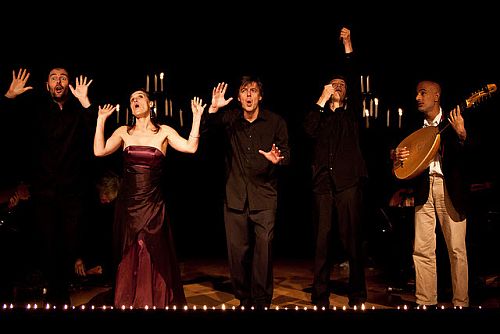 United States Venezia from the Streets to the Palaces: Le Poème Harmonique, Miller Theater, Columbia University, New York, 12.9.2012 (SSM)
United States Venezia from the Streets to the Palaces: Le Poème Harmonique, Miller Theater, Columbia University, New York, 12.9.2012 (SSM)
Claudio Monteverdi: “Dormo Ancora”
Dario Castello: Sonata Concertate in Stil Moderno
Monteverdi: “Lamento della Ninfa”
Francesco Manelli: Bergamasca: La Barchetta passaggiera
Benedetto Ferrari: Chi non sà come Amor
Son ruinato
Anonymous: Villanella ch’all’acqua vai
Manelli: Canzonetta; “Sguardo lusinghiero”
Jacarà: Aria alia napolitana
Ciaccona: Acceso mio core

Taking advantage of the paucity of major musical events between the end of the festivals and the opening of the autumn concert and opera season, Columbia University’s Miller Theater presented a semi-staged program of the music of Venice from the middle and late 17th century. It was a wise decision: New Yorkers and visitors filled the Miller Theater the first night, and the second and final performance was completely sold out. Music from this period is not often played in venues of this size, and it is not always easily appreciated. Although considered part of the Baroque era (1600-1750), the music creates a completely different sound-world than that of even a decade or two later. The opening aria from Monteverdi’s Il ritourno d’Ulisse in patria, for example, written in 1640, is miles apart from the arias of Cavalli’s later operas of the 1650s and 1660s and light-years away from the operas of Purcell in the 1680s and 1690s.
Le Poème Harmonique set out to recreate the atmosphere and dynamics of a concert in 17th-century Venice. Certainly, a great effort was made to determine which instruments would accurately reproduce the sounds of that period. All were original or replicas of original instruments, some rarely seen: a lirone, a viola da gamba-like instrument; a colascione, a long-necked lute; a violone, an early version of the double-bass. When pizzicato was required the bowed instruments were moved horizontally and plucked like guitars. All the musicians appeared relaxed and played as if they were part of a private consort. Johannes Frisch in particular was exceptional, handling the difficult violin passages with ease.
The stage was lit by candles and dim lights on the music stands; midway through, a few more lights appeared at the front of the stage. The long wait for the first piece to begin may have been planned to give the audience time to get in the mood. When tenor Jan Van Elsaker slowly came on stage, he did so with small steps and hand gestures, and the opening aria could not have been more appropriate: “I do not know if I am awake, or if I dream still.” Unfortunately, this would not have been recognized by many in the audience – even if everyone had been given the texts and translations – as we were all literally in the dark. In order to experience something close to an original performance, you need to understand what the vocalist is singing. For the most part, the soloists neither acted nor mimed clearly enough to give more than a general sense of the texts.
And what a shame! The one masterpiece here, Monteverdi’s “Lamento della Ninfa,” as poignant as it is without words, is so much more so if they are understood. Monteverdi was a tone-painter. For example, the effect of the dissonant double suspension on the opening chorus’s “her grief was visible” is lessened without the context. Similarly, it would have been more compelling had we known that “her lost love she thus lamented” was the reason the trio ends their choral commentary on a dying fall. Although the three male voices sang with appropriate expressiveness, Claire Lefillâtre pushed her voice a little too operatically. This madrigal succeeds best when sung by a cooler and whiter voice then Lefillâtre used here. (Having heard her earlier this year performing Couperin’s Leçons de ténèbres, I know her voice has that capability.)
Making it even more difficult to follow, one piece ran into the other without a gap. Of course, it would not be in the spirit of 17th-century Italy to have translated super-titles, but then again we were all sitting in an “inauthentic” air-conditioned theater.
In spite of these qualms, I thought the performance had tremendous energy and enough variety to hold the audience, and responding to sustained applause, two encores followed. Whether totally successful or not, the show did reflect the Miller Theater’s willingness to explore less visited corners of music history, and I look forward to an adventuresome season ahead.
Stan Metzger